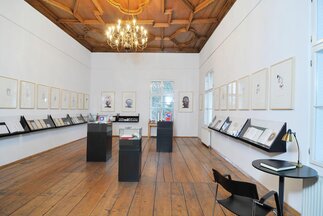Visit us at
Stefan Zweig bust at the Kapuzinerberg in Salzburg | © Tourismus Salzburg Gmbh / K. Brugger
Art & Culture
In Salzburg's literary footsteps
Salzburg, famed as the birthplace of composer extraordinary Wolfgang Amadeus Mozart, is less well-known for its literary greats. We intend to change this, and to turn the spotlight on the Who's Who of the literary scene.
Join us for surprises; we meet in the Café Bazar for a mélange, bitter, sweet, and always animating – much like the walk we're about to take. You might like to order one of those tempting pastries or a pair of savoury frankfurters, and while you wait, absorb the ambience that has inspired so many to become writers. This renowned "home from home" for people who need company to be alone has been the haunt of Max Reinhardt, Hugo von Hofmannsthal, Marlene Dietrich, Stefan Zweig, Thomas Mann, Romy Schneider, Oskar Werner, Arthur Miller and Thomas Bernhard, to mention only a few. Thomas Bernhard even admitted: As others are drawn to the park or the woods, I have always turned to the coffee-house for distraction and calm, my whole life.
The harmony of the various colours and hues completes what in fact requires no completion.
Thus fortified, we leave our cosy, fragrant retreat and take a first look across the Salzach: The rooftops shine green, grey and red. Above them rise the Cathedral towers, the dark grey and wine-red roof of the Franciscan Church, the old-rose towers of the Collegiate Church with its statues of the saints, the grey-green tower of the Glockenspiel and other red and green domes and towers. You can see a whole symphony of colours! – we can still hear Erich Kästner's enthusiastic voice.
Dream and troubled mind
At the Engel Apotheke in the Linzergasse, we read Georg Trakl's poem Im Dunkel [in the dark]. He served his apprenticeship here, before volunteering for military service in World War I.
Further up the street is St Sebastian's Cemetery which, for Thomas Bernhard was the most eerie and thus most fascinating [place], in which he often spent many hours. If we let our gaze wander over the graveyard, we can empathise with this mood. Buried here are the legendary physician Paracelsus, Mozart's wife Constanze and his father.
Yesterday's world
On the way back to the Salzach, we take the old Way of the Cross up to the Capuchin monastery. On the way, we glimpse the Paschinger Schlössl, where Stefan Zweig lived from 1919 to 1934. He is remembered today by the street name and the bust in front of the monastery. Exiled by the National Socialists, he wrote plaintively: I could have seen my house on the hill from the train window, with all the memories of the year I lived there. But I did not look. What for?
Before we descend the steep Imberg staircase, we can enjoy the view over the Old Town in the words of the otherwise so critical Thomas Bernhard: I have very often come to recognise and love the singular essence and the absolute particularity of this, my mother- and fatherlandscape with its (renowned) nature and (renowned) architecture.
We cross the Staatsbrücke and arrive at the Alter Markt. Tomaselli's must be nearly as old as coffee drinking in Europe, wrote Erich Kästner, a frequent patron, as was Stefan Zweig.
Now to the Residenzplatz, the nefarious scene of the National Socialists' book-burning.
At the Cathedral we remember the enamoured 14th-century Monk of Salzburg who composed many love lyrics, besides the oldest German-language Christmas carol still sung, Joseph, lieber Joseph mein!. Joseph Mohr, who wrote the words of the world-famous carol Stille Nacht! Heilige Nacht! [Silent Night] was baptised in the Cathedral.
Oben auf der Kammstrasse, bei den Laternen [Up on the Kammstrasse, by the streetlamps] (Peter Handke)
Looking up towards Hohensalzburg Fortress, we walk over to the Festungsgasse, as far as the footpath named after artist Oskar Kokoschka, who lived at number 33. Along a dip in the road and past the Frey Villa, we reach the Konstantin tower at Mönchsberg 17/17a, where composer Gottfried von Einem lived during the 1940s, and where Bertolt Brecht – whom he had commissioned to write a play to replace Hofmannsthal's Jedermann [Everyman] – was his guest in 1949. Brecht wrote several scenes of the Salzburger Totentanz here, but he was boycotted, and both he and von Einem had to leave the town.
Thirty years later, Peter Handke and his daughter moved into the house and stayed there for almost ten years. Works he wrote while living on the Mönchsberg, were a not inconsiderable contribution to his award of the 2019 Nobel Prize for Literature.
Nun sehe ich den berg, sein fuß berührt eben noch den meinen [Now I can see the mountain – its foot is just touching mine] (H.C.Artmann)
We turn left and follow the narrow path up to the Richterhöhe and the mediaeval defence wall, where the view to the south is spread out. Below the trees we can see Leopoldskron Palace, Max Reinhardt's beloved domicile, and the perfectly straight line of the Moosstrasse, where H.C. Artmann lived. Rising steeply in the background is the Untersberg, which since time immemorial has housed wise women, dwarfs and two emperors.
We suddenly realise where the myth of Salzburg comes from – the symbiosis of culture and nature, a phenomenon that has lent its charm to the town since the literature of the 19th century.
- Pure walking time: approx. 1 hour
- Length: 3 km
- Route at Google Maps
More about
- the Literaturhaus
and - the Literaturfest (in german)





















